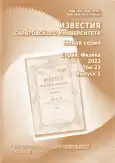Interrelation between pulse wave forms in the peripheral arteries registered by methods of impedance rheography and ultrasonic dopplerography
- Authors: Zaletov I.S.1, Sagaidachnyi A.A.1, Skripal A.V.1, Klochkov V.A.2, Mayskov D.I.1, Fomin A.V.1
-
Affiliations:
- Saratov State University
- Saratov State Medical University named after V. I. Razumovsky
- Issue: Vol 23, No 1 (2023)
- Pages: 24-36
- Section: Articles
- URL: https://journals.rcsi.science/1817-3020/article/view/250724
- DOI: https://doi.org/10.18500/1817-3020-2023-23-1-24-36
- EDN: https://elibrary.ru/BHJEOX
- ID: 250724
Cite item
Full Text
Abstract
About the authors
Ivan Sergeevich Zaletov
Saratov State University410012, Russia, Saratov, Astrakhanskaya street, 83
Andrey Aleksandrovich Sagaidachnyi
Saratov State University410012, Russia, Saratov, Astrakhanskaya street, 83
Anatoly Vladimirovich Skripal
Saratov State University410012, Russia, Saratov, Astrakhanskaya street, 83
Viktor Alexandrovich Klochkov
Saratov State Medical University named after V. I. RazumovskyBolshaya Kazachia st., 112 Saratov, 410012 Russia
Dmitriy Igorevich Mayskov
Saratov State University410012, Russia, Saratov, Astrakhanskaya street, 83
Andrey Vladimirovich Fomin
Saratov State University410012, Russia, Saratov, Astrakhanskaya street, 83
References
- Huisman M. V., Böller H. R., ten Cate J. W., Vreeken J. Serial impedance plethysmography for suspected deep venous thrombosis in outpatients // New England Journal of Medicine. 1986. Vol. 314, № 13. P. 823–828. https://doi.org/10.1056/NEJM198603273141305
- Liu S. H., Cheng D. C., Su C. H. A cuffless blood pressure measurement based on the impedance plethysmography technique // Sensors. 2017. Vol. 17, № 5. Article number 1176. https://doi.org/10.3390/s17051176
- Huynh T. H., Jafari R., Chung W. Y. Noninvasive cuffless blood pressure estimation using pulse transit time and impedance plethysmography // IEEE Transactions on Biomedical Engineering. 2018. Vol. 66, № 4. P. 967–976. https://doi.org/10.1109/TBME.2018.2865751
- Soukup L., Hruskova J., Jurak P., Halamek J., Zavodna E., Viscor I., Vondra V. Comparison of noninvasive pulse transit time determined from Doppler aortic flow and multichannel bioimpedance plethysmography // Medical & Biological Engineering & Computing. 2019. Vol. 57, № 5. P. 1151–1158. https://doi.org/10.1007/s11517-018-01948-x
- Mašanauskienл E., Sadauskas S., Naudžiūnas A., Unikauskas A., Stankevičius E. Impedance plethysmography as an alternative method for the diagnosis of peripheral arterial disease // Medicina. 2014. Vol. 50, № 6. P. 334–339. https://doi.org/10.1016/j.medici.2014.11.007
- Кобрисев П. А., Туйкин Т. С., Корженевский А. В. Разработка бесконтактного монитора жизненных показателей человека // Журнал радиоэлектроники [электронный журнал]. 2017. № 4. URL: http://jre.cplire.ru/jre/apr17/10/text.pdf (дата обращения: 08.09.2022).
- Brown B. H., Pryce W. I. J., Baumber D., Clarke R. G. Impedance plethysmography: Can it measure changes in limb blood flow // Medical and Biological Engineering. 1975. Vol. 13, № 5. P. 674–682. https://doi.org/10.1007/BF02477325
- Цой М. О., Постнов Д. Э. Метод выделения значимых компонент для оценки вариабельности формы пульсовых волн // Известия Саратовского университета. Новая серия. Серия : Физика. 2021. Т. 21, вып. 1. С. 36–47. https://doi.org/10.18500/1817-3020-2021-21-1-36-47
- Залетов И. С., Клочков В. А., Сагайдачный А. А., Скрипаль Ан. В., Фомин А. В. Импедансная реография периферических артерий высокой степени локализации при воздействии гравитационной пробы // Методы компьютерной диагностики в биологии и медицине-2021 : сборник статей Всероссийской школы-семинара. Саратов : Саратовский источник, 2021. С. 27–31.
- Wilder-Smith E., Liu L., Ma K. T. M., Ong B. K. Relationship of inspiratory flow rate and volume on digit tip skin and ulnar artery vasoconstrictor responses in healthy adults // Microvascular Research. 2005. Vol. 69, № 1–2. P. 95–100. https://doi.org/10.1016/j.mvr.2005.01.003
- Allen J., Frame J. R., Murray A. Microvascular blood flow and skin temperature changes in the fingers following a deep inspiratory gasp // Physiological Measurement. 2002. Vol. 23, № 2. P. 365. https://doi.org/10.1088/0967-3334/23/2/312
- Mayrovitz H. N., Groseclose E. E. Neurovascular responses to sequential deep inspirations assessed via laser-Doppler perfusion changes in dorsal finger skin // Clinical Physiology and Functional Imaging. 2002. Vol. 22, № 1. P. 49–54. https://doi.org/10.1046/j.1475-097x.2002.00404.x
- Сагайдачный А. А., Скрипаль А. В. Окклюзионная проба: биофизические механизмы реакции, методы анализа, перспективы применения: учебное пособие для студентов. Саратов : Изд-во «Саратовский источник», 2019. 81 с.
- Аникина Н. Ю., Коровина В. А., Тарасова А. В., Ушакова Н. Я., Ярошенко Ю. А. Гидродинамика. Физические основы гемодинамики: учебно-методическое пособие. Архангельск : Изд-во Северного государственного медицинского университета, 2021. 111 с.
- Bernstein D. P. Impedance cardiography: Pulsatile blood flow and the biophysical and electrodynamic basis for the stroke volume equations // Journal of Electrical Bioimpedance. 2010. Vol. 1, № 1. P. 2–17. https://doi.org/10.5617/jeb.51
- Ramalli A., Aizawa K., Shore A. C., Morizzo C., Palombo C., Lenge M., Tortoli P. Continuous simultaneous recording of brachial artery distension and wall shear rate: A new boost for flow-mediated vasodilation // IEEE Transactions on Ultrasonics, Ferroelectrics, and Frequency Control. 2018. Vol. 66, № 3. P. 463–471. https://doi.org/10.1109/TUFFC.2018.2889111
- Kubicek W. G., From A. H., Patterson R. P., Witsoe D. A., Castaneda A., Lillehei R. C., Ersek R. Impedance cardiography as a noninvasive means to monitor cardiac function // JAAMI: Journal of the Association for the Advancement of Medical Instrumentation. 1970. Vol. 4, № 2. P. 79–84.
- Shimazu H., Yamakoshi K. I., Togawa T., Fukuoka M., Ito H. Evaluation of the parallel conductor theory for measuring human limb blood flow by electrical admittance plethysmography // IEEE Transactions on Biomedical Engineering. 1982. Vol. 1. P. 1–7. https://doi.org/10.1109/TBME.1982.324957
- Eicke B. M., Milke K., Schlereth T., Birklein F. Comparison of continuous wave Doppler ultrasound of the radial artery and laser Doppler flowmetry of the fingertips with sympathetic stimulation // Journal of Neurology. 2004. Vol. 251, № 8. P. 958–962. https://doi.org/10.1007/s00415-004-0471-7
Supplementary files









